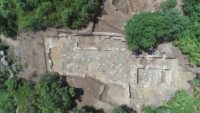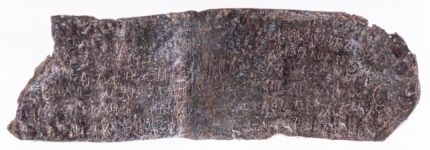 A lead plate amulet discovered in the medieval fortress of Balak Dere near the village of Huhla, in southern Bulgaria, bears one of the earliest known inscriptions in Cyrillic. The amulet was unearthed last autumn in a layer with artifacts dating to the first half of the 10th century. Epigraphic analysis of the inscription confirms the date based on the archaic style of lettering.
A lead plate amulet discovered in the medieval fortress of Balak Dere near the village of Huhla, in southern Bulgaria, bears one of the earliest known inscriptions in Cyrillic. The amulet was unearthed last autumn in a layer with artifacts dating to the first half of the 10th century. Epigraphic analysis of the inscription confirms the date based on the archaic style of lettering.
It was found folded in half and in dire need of cleaning. The inscription was not initially visible to the naked eye. The photographer documenting the find spotted the writing first, and only after an cleaning and conservation could researchers begin to decipher the inscriptions. Reflectance Transformation Imaging (RTΙ) photography was used to make out the hard-to-read lettering.
There are seven rows of text on the inside of the folded rectangular plate and four rows on the outside. They contain prayers for the protection of named individuals. The plate was worn as a pendant to protect the wearer.
It was believed that such apotropaic amulets protected their owner from the evil eye, magic spells and disease. Around 50-60 such 10th century artefacts found in Northeastern Bulgaria have so far been studied, but the find in Balak Dere is unique, with no equivalent so far, researchers say.
“The difference is that what we have here is a supplication, even the names of the supplicants are known – Nikola and Pavel,” [excavation leader] Ivaylo Kanev explains. “They are asking St. Dimitar to intercede with God on their behalf and protect them from such-and-such calamities, as, the authors say, and I will quote the last line which is very canonical and astonishing, because we have never seen anything like it before: “…wash his face with grace, exonerate the shame, heal, oh, Saint, because His is the glory, and the honour, and the state, now and forever, Amin!” Very well structured, like a canon, there are no simple wishes here. That is the other novelty.”
 Recent excavations at the hilltop site have uncovered evidence that the fortress was in use off and on from the 4th until the early 13th centuries. It was part of a system of fortresses built in the middle of the 4th century to defend the imperial capital of Constantinople. It was burned down at the end of the 5th century but quickly rebuilt.
Recent excavations at the hilltop site have uncovered evidence that the fortress was in use off and on from the 4th until the early 13th centuries. It was part of a system of fortresses built in the middle of the 4th century to defend the imperial capital of Constantinople. It was burned down at the end of the 5th century but quickly rebuilt.
It was destroyed again by the Avars in the early 7th century and was only reoccupied in the 10th century when troops of Bulgarian Tsar Simeon I the Great (r. 893-927) used it during the king’s wars against the Byzantine Empire. What went around came around in the 12th century when the troops of Byzantine Emperor Alexios I Komnenos (r. 1081-1118) occupied the fortress. The site was permanently abandoned in the first quarter of the 13th century.
The archaeological layer the lead plate amulet was found in spurred archaeologists to compare the inscription to Cyrillic writing from Tsar Simeon’s rule. Cyrillic was developed in the 890s at the Preslav Literary School in the Bulgarian capital of Pliska. The earliest dateable Cyrillic inscriptions on the record have been found there, with the earliest dating to 921. Simeon’s Bulgarian troops were at Balak Dere between 916 and 927, so this amulet may be THE earliest known Cyrillic inscription, not just one of the earliest.

There were already ROMAN lead cursing pendants, but here we seem to have a Christian one.
Of particular interest might be, therefore, if there are also types in between, maybe in some form of runic inscriptions that later the Greek missionary Cyril –who died in 869AD in Rome– and his friends seem to have turned into “Cyrillic” script.
Bulgaria, by the way, is not to be confused with “Volga Bulgaria”: Volga Bulgaria adopted Islam in 922, and Ahmad ibn Fadlan had been sent from Baghdad as an ambassador and traveler. Ibn Fadlan left an account of his travels under the Abbasid caliph, al-Muqtadir of Baghdad, to the king of the Volga Bulgars.
Here, he also describes traders that by the time of his visit apparently were not so Islamic, Christian or anything else (he also describes a ship burial and human sacrifice):
——
“I saw the Rusiyyah when they had arrived on their trading expedition and had disembarked at the River Atil. (…) The man wears a cloak with which he covers one half of his body, leaving one of his arms uncovered. Every one of them carries an axe, a sword and a dagger and is never without all of that which we have mentioned. (…)
Each man, from the tip of his toes to his neck, is covered in dark-green lines, pictures and such like. Each woman has, on her breast, a small disc, tied around her neck, made of either iron, silver, copper or gold, in relation to her husband’s financial and social worth. Each disc has a ring to which a dagger is attached, also lying on her breast. Around their necks they wear bands of gold and silver. (…)
They are the filthiest of all Allah’s creatures: they do not clean themselves after excreting or urinating or wash themselves when in a state of ritual impurity (i.e., after coitus …). Indeed they are like asses that roam in the fields. They arrive from their territory and moor their boats by the Atil (a large river), building on its banks large wooden houses. They gather in the one house in their tens and twenties, sometimes more, sometimes less. Each of them has a couch on which he sits.
They are accompanied by beautiful slave girls for trading. One man will have intercourse with his slave-girl while his companion looks on. Sometimes a group of them comes together to do this, (…) They cannot, of course, avoid washing their faces and their heads each day, which they do with the filthiest and most polluted water imaginable. I shall explain … ” (…)
——